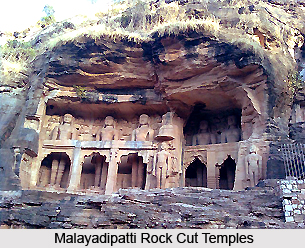 The Malayadipatti rock-cut Hindu temples in Tamil Nadu, situated in the granite hillocks, south of the Malayadipatti village, are pregnant with stone figurines and carvings; moreover there are painted stuccos that engross these statuettes. There are 3 caves that served the purpose of housing Jain monks, during the 3rd - 4th century AD. There are cupules present in these caves that are traced back up to 3 thousand years ago. The ceilings and walls in Olipathivishnu Vishnugraham, on of the two temples in Malayadipatti, are adorned with exquisite paintings, but these appear to be comparatively new, that is between the period from16th - 17th century.
The Malayadipatti rock-cut Hindu temples in Tamil Nadu, situated in the granite hillocks, south of the Malayadipatti village, are pregnant with stone figurines and carvings; moreover there are painted stuccos that engross these statuettes. There are 3 caves that served the purpose of housing Jain monks, during the 3rd - 4th century AD. There are cupules present in these caves that are traced back up to 3 thousand years ago. The ceilings and walls in Olipathivishnu Vishnugraham, on of the two temples in Malayadipatti, are adorned with exquisite paintings, but these appear to be comparatively new, that is between the period from16th - 17th century.
Hindu Temples of Malayadipatti
There are two temples in Malayadipatti, one of Lord Shiva and the other Lord Vishnu, and both temples are situated in the same granite hillside, which is inclined in towards the east-west direction. The temples are actively worshipped till this day and religious services are held from time to time. Other than the temples, there are ancient rock cut buildings, a shrine and a kitchen, within the same vicinity.
Shiva Temple of Malayadipatti
The Shiva temple, popularly known as Alathurthali, is situated towards the eastern side of the granite hill, and is placed a little higher, above the Vishnu temple. It has been derived from inscriptions, that the temple was unearthed in 804 AD.
There is a mandapa in the temple and towards the eastern region; a cubical chamber is present inside the mandapa. There are 4 pillars in the mandapa, and the two back pillars are linked with an arch-shaped structure, that hosts statuettes of Vinayaga and Muruga, on a raised area. The mandapa is more than 6 m in length and 4.5 m in width. There is a figurine of Chandeshwara and a statuette of Nandi bull, which faces the chamber. The entrance gateway is guarded by figures of ancient guards or dvarapalas. There is also a Shiva Lingam that is cut from the main rock face. There is a panel containing 7 goddesses towards the south potion of the wall. The panel known as Saptamatrika is placed between sculptures of Veerabhadra and Ganesha. There is another panel on the west that contains figures of deities like Sankaranarayana, Muruga, but has been damaged.
Vishnu Temple of Malayadipatti
The Vishnu temple, near the western side of the hillock, is popularly known as Olipathivishnu Vishnugraham, has been modified into a multifaceted complex structure over the periods of history. The rock-cut Vishnu temple includes numerous paintings and artworks, various statuettes and sculptures, painted stucco and painting on walls and ceiling. Lord Vishnu or Perumal, as popularly known in Tamil Nadu, is worshipped in the temple. There are also shrines of Shiva, Vishnu and other gods. The Rock-cut temple contains a verandah (mukha-mandapa), an entrance chamber (ardha-mandapa) and a shrine. Almost the entire inner surface is adorned with paintings, sculptures and stucco.
There is sculpture of Kanniraintha Perumal or Lord Vishnu and Lakshmi, where Vishnu appears to hold a sacred conch, called sangu, and a chakra. There are figures of Shiva, Nrsimhadeva, Brahma and other gods and deities. This entire sculpture is painted and covered with stucco. These artworks appear to be made during 16th - 17th century AD, which is much later than the period when the rock cut temples were made. Another wall is contains sculptures of Vishnu and Brahmadeva, sitting on atop a lotus. Gandharvas appear above the head of Brahma. There are figures of demons, like Thakkan, Kaitabha, Madhu, inside the rock cut temple as well. There are paintings on the ceiling that depict the incarnations of Vishnu, the Dashavatara. There is also a flat-roofed structure, decorated with statuettes of elephants and birds along with figures of mutated mythological creatures known as makaras. There is a statue of Ganesha, facing the north, outside the entrance. The Vishnu temple and cave contains 10 inscriptions that were made approximately during 960 AD.
Natural Caverns with Ancient Monuments
There are 3 natural rock shelters in Malayadipatti, which include fascinating monuments of the ancient period. 400 ancient cupules are found in 2 caves that were apparently created around 3000 years ago. There is a white painting of a human and a bird that is probably made out of lime, in another cave. Another cave contains inscriptions related to Brahmi script.



















